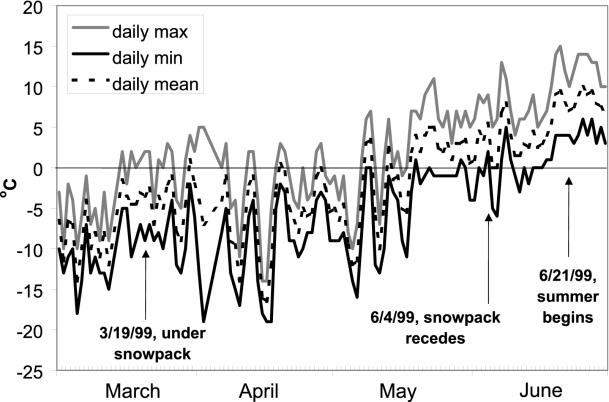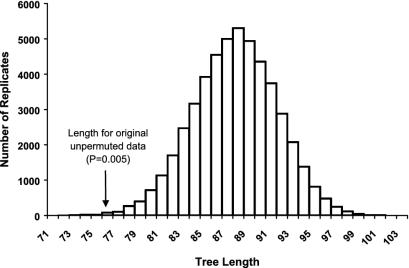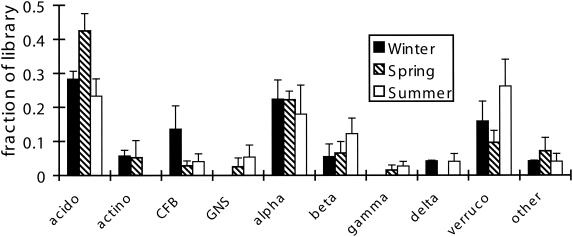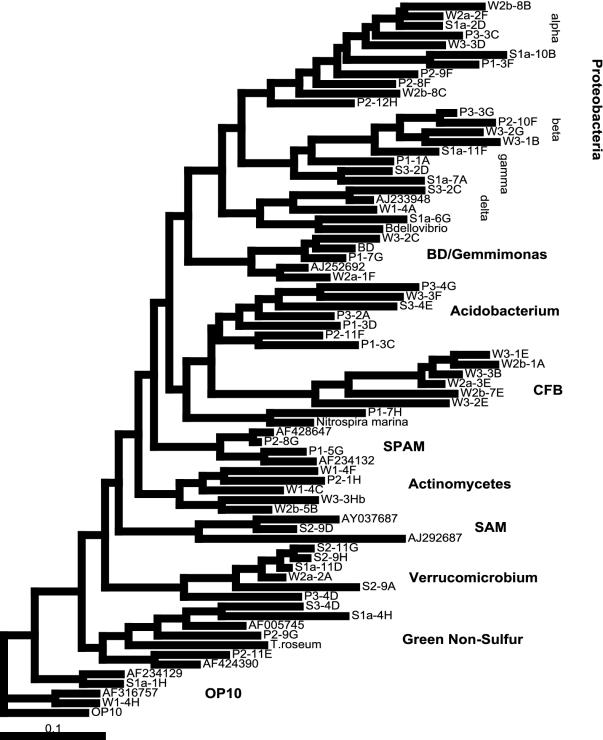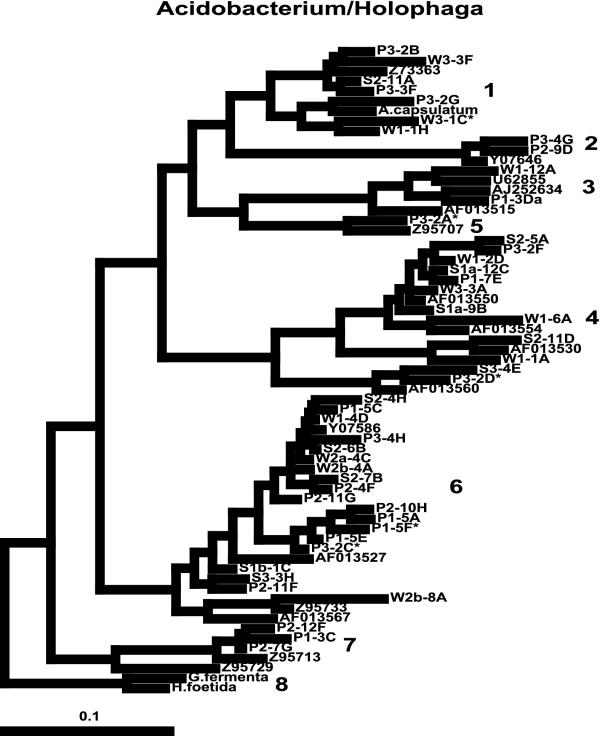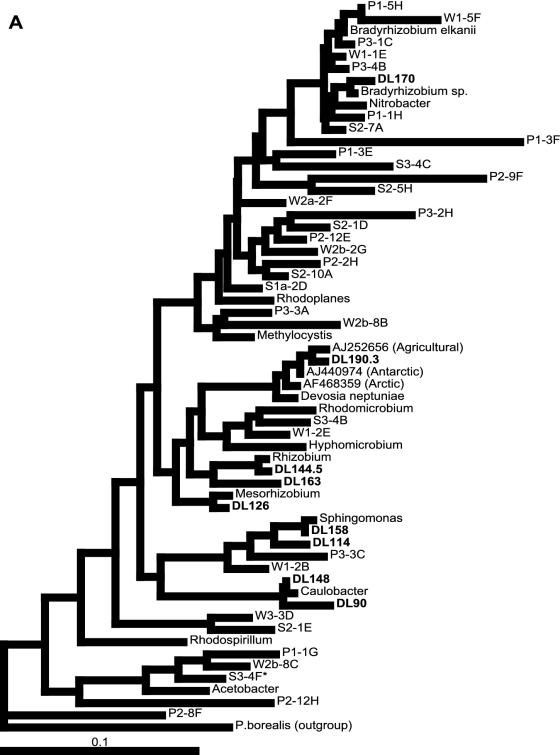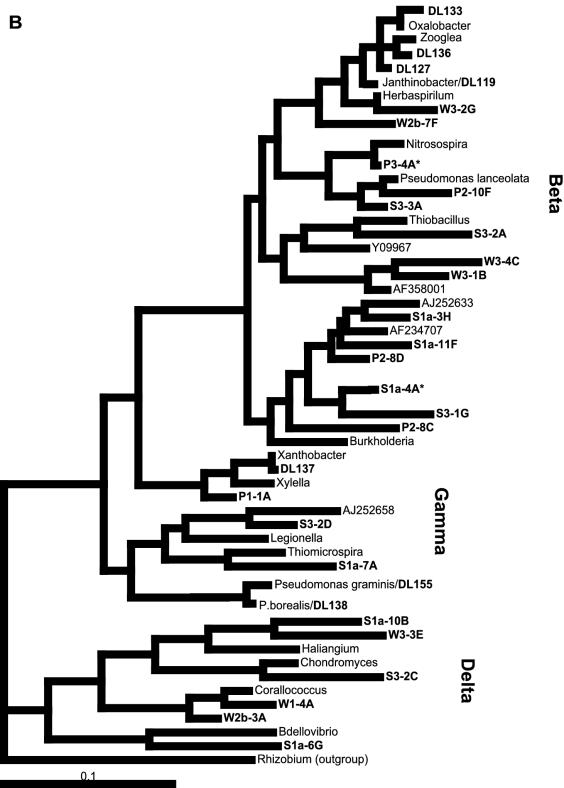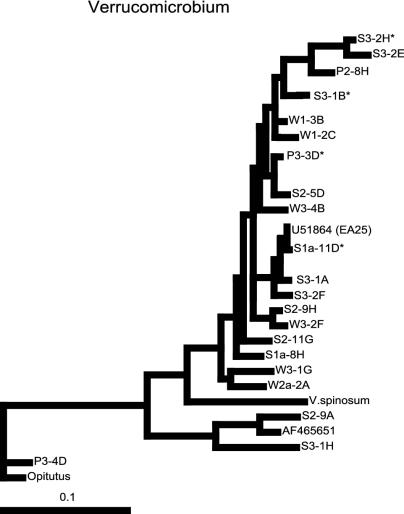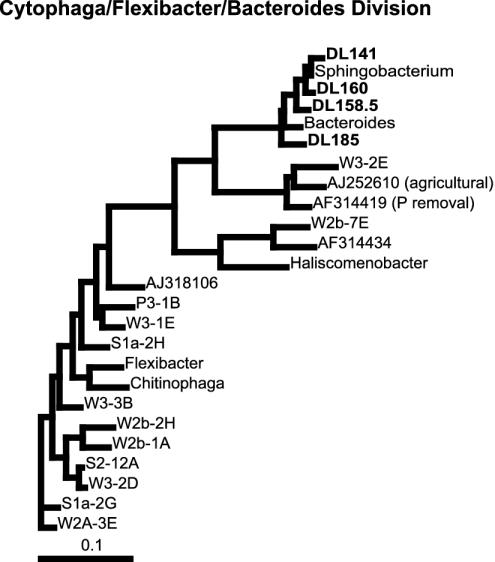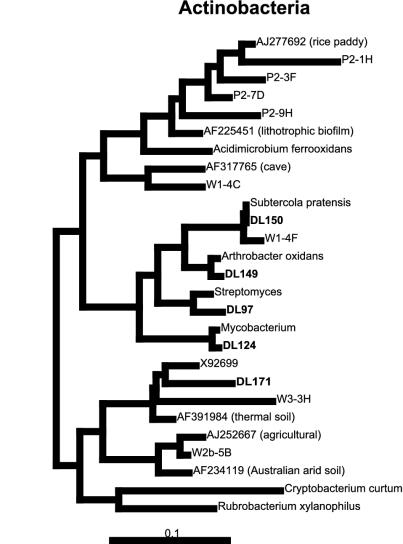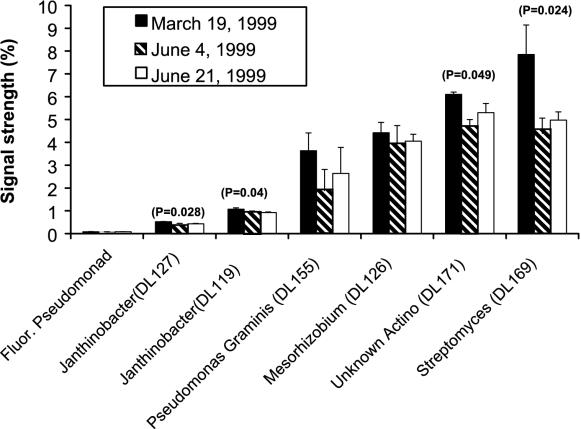Abstract
The period when the snowpack melts in late spring is a dynamic time for alpine ecosystems. The large winter microbial community begins to turn over rapidly, releasing nutrients to plants. Past studies have shown that the soil microbial community in alpine dry meadows of the Colorado Rocky Mountains changes in biomass, function, broad-level structure, and fungal diversity between winter and early summer. However, little specific information exists on the diversity of the alpine bacterial community or how it changes during this ecologically important period. We constructed clone libraries of 16S ribosomal DNA from alpine soil collected in winter, spring, and summer. We also cultivated bacteria from the alpine soil and measured the seasonal abundance of selected cultured isolates in hybridization experiments. The uncultured bacterial communities changed between seasons in diversity and abundance within taxa. The Acidobacterium division was most abundant in the spring. The winter community had the highest proportion of Actinobacteria and members of the Cytophaga/Flexibacter/Bacteroides (CFB) division. The summer community had the highest proportion of the Verrucomicrobium division and of β-Proteobacteria. As a whole, α-Proteobacteria were equally abundant in all seasons, although seasonal changes may have occurred within this group. A number of sequences from currently uncultivated divisions were found, including two novel candidate divisions. The cultured isolates belonged to the α-, β-, and γ-Proteobacteria, the Actinobacteria, and the CFB groups. The only uncultured sequences that were closely related to the isolates were from winter and spring libraries. Hybridization experiments showed that actinobacterial and β-proteobacterial isolates were most abundant during winter, while the α- and γ-proteobacterial isolates tested did not vary significantly. While the cultures and clone libraries produced generally distinct groups of organisms, the two approaches gave consistent accounts of seasonal changes in microbial diversity.
Natural microbial communities are complex and mysterious entities. The advent of culture-independent methods for describing the diversity of bacterial communities has revealed a vast assortment of uncultured bacterial species whose environmental roles are unknown (41). Simultaneously, it is becoming recognized that the composition of microbial communities can have important effects on ecological processes (27, 34, 47). Studies that link microbial community composition to the functioning of ecosystems are needed.
The alpine ecosystem of the Colorado Rocky Mountains affords an opportunity for such a study. Our previous work has linked changes in microbial population dynamics to the availability of nitrogen (N) for alpine plants (30). Microbial biomass grows to its highest levels during the winter and early spring, when soils are frozen. Shortly after snow melts in the spring, biomass begins to rapidly turn over, and biomass levels are dynamic throughout the summer. This seasonal turnover of biomass leads to large fluxes of organic N that alpine plants can utilize for growth (33). The biomass dynamics after snowmelt are brought on, in part, by changes in substrate availability and temperature (31) and are accompanied by changes in microbial community composition (34). The winter community has a greater fungal component, differs in its response to temperature, and preferentially degrades cellulose and phenolic compounds, when compared to the summer community. Community DNA hybridization studies showed that the communities differ genetically but did not provide specific information on alpine soil microbial diversity. It has been recently shown that the alpine soil fungal community changes between winter and summer and contains previously undescribed subphylum and class-level diversity (46). Based on these observed seasonal changes in microbial community structure and function, we hypothesize that the bacterial community changes between winter and summer. Furthermore, because microbial diversity is understudied in alpine soils and the fungal diversity has already been shown to be novel, it is likely that the bacterial community contains novel lineages as well. The purpose of the present study was to use culture-based and culture-independent approaches to describe changes in the bacterial community over the ecologically crucial period of time between winter and summer. This information may help explain the physiological characteristics of the microbial community as a whole. Because seasonal changes in ecosystems are generally predictable, recurring phenomena, they are good opportunities to study how microbial communities respond to their environment (3, 6, 50, 57). Seasonal changes in microbial biomass can have important ramifications for nutrient cycling and ecosystem functioning (30, 32, 49, 54, 55). This type of study affords a chance to see how changes in community composition scale up to affect ecosystem processes.
METHODS AND MATERIALS
Study site and sample collection.
The study area is located at the Niwot Ridge Long Term Ecological Research area in the Front Range of the Colorado Rocky Mountains (40o03′N, 105o35′W).The alpine dry meadow site used in this study is dominated by the tussock-forming sedge, Kobresia myosuroides (Vill) Paol. and Fiori. The soil is classified as a skeletal-loamy pergelic Cryumbrept (7). The site used in this study (site B in reference 43) has an elevation of 3,550 m and an eastern exposure. The soil is particularly shallow, with a 10-cm A horizon overlaying a rocky B horizon with very few K. myosuroides roots. The A horizon contains 81 g of C kg−1 and 7.4 g of N kg−1 (43). All experiments herein were performed on A horizon soil. The dry meadow is generally snow free from May/June to October/November. The main soils used in this study were collected in 1999 on March 19 (winter samples), June 4 (spring samples), and June 21 (summer samples). The winter samples were collected from under snow, when soils were frozen; the spring samples were collected shortly after snow receded from the site and soils thawed; and the summer samples were collected after minimum daily air temperatures had warmed significantly and the daily minimum temperatures were consistently above freezing (Fig. 1). Bacterial cultures were also obtained from soils collected on other dates as indicated in the text. On each collection date, three soil cores (10 cm deep, 5 cm in diameter) were collected. To maintain consistency with respect to the effect of the proximity of plants, each sample was collected directly alongside a tussock of K. myosuroides. Soil samples were collected 1 to 10 m apart from each other. Soils were sealed in plastic bags and brought to the laboratory for analysis. Soil was coarsely sieved (4.75 mm) to remove rocks and large roots. Soils were stored at −70°C for up to 6 months before DNA extraction.
FIG. 1.
Maximum, minimum, and average daily air temperatures for the Saddle climate monitoring station on Niwot Ridge for the period in 1999 during which the primary samples for this study were collected.
General soil microbiological properties.
Total biomass and potentially active microbial biomass were measured by using glutamate substrate-induced growth response (SIGR) and chloroform fumigation-extraction methods, respectively (30). The SIGR method measures the quantity of biomass capable of growing on a given substrate. The substrate, potassium glutamate, can be used for growth by many heterotrophic microbes, and glutamate SIGR is correlated with a variety of microbial biomass measures (30). Total bacterial and fungal populations were measured by light microscopic methods (34). The data shown in Table 1 are from a variety of winter and summer dates between 1996 and 2001.
TABLE 1.
General microbiological properties of alpine dry meadow soilsa
| Season | Microbial biomass of C (μg of C/g of soil)b | Glutamate SIGR (μg of C/g of soil)c | Bacterial counts (109 cells/g of soil)d | Fungal counts (m of hyphae/g of soil)d | Fungal/bacterial biomass (g of fungi/g of bacteria)d |
|---|---|---|---|---|---|
| Winter | 655 ± 19 | 268 ± 31 | 6.2 ± 0.34 | 193 ± 16 | 1.62 ± 0.12 |
| Summer | 422 ± 56 | 137 ± 33 | 21.6 ± 1.7 | 127 ± 34 | 0.32 ± 0.11 |
Alpine dry meadow soils were collected from under snowpack (Winter) or 2 to 6 weeks after the disappearance of the snowpack in the late spring or early summer (Summer). Values are means ± standard errors of observations made between 1996 and 2001.
Measured by the chloroform fumigation-extraction method.
Biomass capable of growth on glutamate.
Microscope counts of total bacteria and fungal cells. The ratio is based on conversion from biovolume to biomass.
DNA extraction, purification, and cloning.
DNA was extracted from soil in relatively large samples (3 to 5 g) to include within-sample variation. Extractions were performed as gently as possible, so that relatively large DNA fragments survive the extraction process. Soil was subjected to five freeze-thaw cycles (liquid N2 for 5 min, 65°C for 5 min) and shaken (100 rpm) at 37°C for 2 h in Tris-EDTA-0.2% sodium dodecyl sulfate with proteinase K and lysozyme. DNA was crudely purified by two washes of phenol-chloroform-isoamyl alcohol (25:24:1) and precipitated with isopropanol. Humic substances were removed on Sepharose 4-D columns (Sigma Chemicals, St. Louis, Mo.) (53), and DNA was further purified by using QiAmp tissue columns (Qiagen).
Bacterial 16S ribosomal DNA (rDNA) was amplified with universal bacterial primers f8-27 (5′-AGAGTTTGATCCTGGCTCAG-3′) and r1510 (5′-GGTTACCTTGTTACGACTT-3′). PCRs were performed with an annealing temperature of 54°C, with 3.0 mM MgCl2, 0.2 mM each deoxynucleoside triphosphate (dNTP), 1 μM each primer, 1 U of Fisher Taq polymerase, and buffer supplied with the enzyme (Fisher Biosciences). To minimize PCR bias (38, 42), each DNA template was amplified by using eight replicate reactions run for only 24 cycles. PCR product was combined from the eight reactions and gel purified with spin columns (Qiagen). The purified product was cloned by using the TOPO TA cloning kit (Invitrogen). Clones from the nine libraries were selected at random and sequenced on an Prism 3100 capillary electrophoresis DNA sequencer (ABI) using universal bacterial primer r1111 (5′-TTGCGCTCGTTGCGGGACT-3′). For selected clones of interest, additional regions were sequenced using universal bacterial primers r536 (5′-GTATTACCGCGGCTGCTGG-3′) and r1510. A total of 217 sequences were produced, ranging from 22 to 26 sequences per spatial replicate and 71 to 73 sequences per season. Of the original 217 sequences, 185 were of sufficient length and quality to include in phylogenetic trees. The remainder were used only for BLAST searches to determine frequency of bacterial divisions within the libraries.
Isolation of bacterial cultures.
Bacteria were isolated from soils by using dilution culture and agar plates under a variety of growth conditions. Growth at low temperatures was emphasized (−1 to 10°C). Most of the isolates used in this study were isolated from environmental samples collected during the same time interval described by the clone libraries (see Table 3). However, this study also made use of isolates obtained at other times. These isolates were included because of their strong hybridization signals or their ability to grow at low temperatures and/or using complex carbon substrates. Freshly collected soils or ion-exchange resins, incubated in situ, were used as the source material. The purpose of incubating ion-exchange resins in the field was to enrich for isolates capable of proliferating in the alpine environment under ambient conditions, using specific compounds, in the hope of obtaining ecologically relevant isolates rather than opportunists that flourish only in the laboratory. For these in situ enrichment experiments, mixed-bed ion-exchange resins were enclosed in nylon mesh, heat sterilized, and soaked in sterile substrate (glutamate or carboxymethylcellulose [CMC]). These were transported to the field in sterile containers, placed in the soil on 19 March 1999, and retrieved on 4 June 1999. Cells associated with soils or resins were extracted and diluted in sterile buffer (1-g/liter MgSO4 · 7H2O, 1 mM K2HPO4, pH 7.0) and plated onto agar plates or into 96-well plates filled with liquid medium. The basal medium contained, per liter, 1 g of MgSO4 · 7H2O, 10 mM K2HPO4 (pH 7.0), 1 mM NH4NO3, 1 ml of soil extract (10:1 water-soil, previously autoclaved and filtered through a 0.2-μm-pore-size filter), and 15 g of agar (for solid medium). Defined carbon sources were added to a final concentration of 1 g/liter and included potassium glutamate, glucose, CMC, starch, and humic acid (Sigma Chemicals). Also, some undefined media were used, including soil extract medium (10:1 water-soil, autoclaved, 0.2-μm-pore-size filtered, 10 mM K2HPO4, pH 7.0), root extract agar (10:1 water-fresh K. myosuroides roots autoclaved and 0.2-μm-pore-size filtered, 1.5% agar, 10 mM K2HPO4, pH 7.0), and glucose-glutamate-soil (GGS) medium (basal medium with 0.5 g of glucose, 0.5 g of potassium glutamate, and 50 ml of soil extract per liter). High-salt agar medium consisted of the basal glucose medium adjusted to a −2-MPa water potential with MgSO4. Colonies from agar plates or from the limiting dilutions of 96-well plates were streaked to isolation three times on solid medium. Isolates were identified by sequencing of the 16S rDNA genes. DNA was isolated by standard methods, and PCR amplification and sequencing were done as described above for soil clones, except 32 PCR cycles were used.
TABLE 3.
Summary of bacterial isolates obtained from alpine soils collected on various dates and grown under a variety of conditionsa
| Isolate | Source material (mo/day/yr) | Growth condition
|
Division | Identity | |
|---|---|---|---|---|---|
| Medium | Temp (°C) | ||||
| DL89, 95-100 | 10/5/1997 soil | CMC agar | 3 | Actino | Streptomyces |
| DL90 | CMC agar | 3 | Alpha | Caulobacter henricii | |
| DL114 | 4/11/1998 soil | Starch agar | 3 | Alpha | Sphingomonas |
| DL119 | Glutamate agar | 3 | Beta | Janthinobacter | |
| DL124 | 3/19/1999 soil | Humics dilution | 3 | Actino | Mycobacterium |
| DL126 | Humics dilution | 3 | Alpha | Mesorhizobium | |
| DL127 | Humics dilution | 3 | Beta | Janthinobacter | |
| DL128, 129 | High-salt agar | 3 | Actino | Arthrobacter | |
| DL143 | GGS agar | −1 | Gamma | Pseudomonas borealis | |
| DL144.5 | GGS agar | −1 | Alpha | Rhizobium | |
| DL148 | GGS agar | −1 | Alpha | Caulobacter henricii | |
| DL149 | GGS dilution | −1 | Actino | Arthrobacter | |
| DL150 | GGS dilution | −1 | Actino | Subtercola/Curtobacterium | |
| DL151, 152 | CMC agar | −1 | CFB | Sphingobacterium | |
| DL153, 156, 158 | CMC agar | −1 | Alpha | Sphingomonas (antarctic) | |
| DL155 | CMC agar | −1 | Gamma | Pseudomonas graminis | |
| DL158.5, 160 | Starch agar | −1 | CFB | Sphingobacterium | |
| DL159 | Starch agar | −1 | Actino | Arthrobacter | |
| DL131 | In situ resin (CMC) | CMC agar | 3 | Alpha | Caulobacter henricii |
| DL133 | CMC agar | 3 | Beta | Oxalobacter | |
| DL140 | CMC agar | −1 | Gamma | Pseudomonas borealis | |
| DL135, 141, 142 | In situ resin (glutamate) | Glutamate agar | −1 | CFB | Sphingobacterium |
| DL136 | Glutamate agar | 3 | Beta | Zooglea | |
| DL137 | Glutamate agar | 3 | Gamma | Xanthomonas | |
| DL138 | Glutamate agar | 3 | Gamma | Pseudomonas borealis | |
| DL163 | 6/16/1999 soil | Humics dilution | 10 | Alpha | Rhizobium |
| DL166 | Humics dilution | 10 | Alpha | Sphingomonas (antarctic) | |
| DL169 | Soil dilution | 10 | Actino | Streptomyces | |
| DL170 | Soil dilution | 10 | Alpha | Bradyrhizobium | |
| DL171 | Soil dilution | 10 | Actino | Unknown actinobacterium | |
| DL184 | 10/15/1999 soil | Casein agar | −1 | Beta | Zooglea |
| DL185 | Casein agar | −1 | CFB | Bacteroides | |
| DL189 | Soil agar | −1 | Actino | Arthrobacter | |
| DL190.3 | Root agar | −1 | Alpha | Devosia | |
See Materials and Methods for details of culturing conditions. Alpha, Beta, and Gamma refer to subgroups of the Proteobacteria; Actino, Actinobacteria.
Measuring seasonal abundance of isolates with dot blots.
Isolates with high or dynamic seasonal abundance were identified by reciprocal sample genome probing (RSGP) (52). One hundred nanograms of isolate DNA (quantified by using PicoGreen; Molecular Probes, Eugene, Oreg.) was blotted onto positively charged nylon membranes (Hybond+; Amersham Pharmacia Biotechnica), and randomly primed probes were made from purified soil DNA (digoxigenin [DIG] Hi-Prime; Roche Biochemicals). Select isolates were then used for dot blotting experiments in which soil DNA from each season and spatial replicate was applied to the blots along with dots of 1 to 100 ng of bacterial DNA as standards and 100 ng of herring sperm DNA as a blank. Randomly primed probes were made from isolate DNA. Details of the blotting procedure were reported earlier (34). Briefly, standard methods were used for blotting and stringent rinses (2). After developing overnight at 22°C, blots were visualized with alkaline phosphatase (AP)-conjugated anti-DIG Fab fragments (Roche Biochemicals) and AttoPhos (JBL, Sunnyvale, Calif.) fluorogenic substrate for AP and were quantified by using a Storm 860 (Molecular Dynamics) with ImageQuant software. Hybridization signals resulting from the isolate probe on each soil DNA dot were standardized by using the isolate DNA standards. The probes also bound to DNA of closely related species, so these data are presented in relative units (percentage of the highest standard), as taking the standard curve literally would produce overestimates of the isolate's abundance.
Phylogenetic and statistical analysis.
Sequences were edited with BioEdit. Chimeric sequences were screened out by using Chimera_Check (http://rdp.cme.msu.edu). Representative guide sequences were selected and downloaded from GenBank (www.ncbi.nlm.nih.gov) by using BLAST searches. Only sequences of 500 bp in length or greater were included in phylogenetic analysis. Sequences were aligned initially by using ClustalW and then adjusted manually. Maximum-likelihood analysis was performed on the sequences by using the FastDNAml algorithm of BioEdit, derived from DNAML from the Phylip package, using empirical base frequencies and a transition/transversion ratio of 2.0. Parsimony and neighbor-joining analysis were performed with Phylip, using 100 bootstrap replicates. Neighbor-joining analysis was performed by the Jin-Nei method, using a gamma factor of 0.1 to allow for different substitution rates between sites. A distance matrix generated by Phylip with the same parameters was used to dereplicate the data set. Sequences not differing by more than 1% were considered identical. These data were used for species rarefaction, richness, and diversity analysis by using EstimateS version 5 software from R. K. Colwell (http://viceroy.eeb.uconn.edu/estimates). Analysis of seasonal differences in the microbial community was performed in two general ways. The first, phylogenetic tree permutation (PTP) analysis, does not rely on frequencies of sequences and so is not subject to PCR bias (37). In PTP analysis, the hypothesis that phylogeny covaries with community type is tested by generating numerous randomly permuted trees and calculating the tree length needed to evolve between community types. The tree length of the original data set is compared to this frequency distribution to produce a probability (P) value. PTP analysis was done by using the PAUP software package. The second approach was to compare seasonal differences in the frequency of major bacterial groups within the clone libraries. This was statistically analyzed in two ways. Analysis of variance (ANOVA) was performed on the percent contribution of each group to the libraries of each soil replicate. Where appropriate, values were log or square root transformed before analysis. In addition, the binomial distribution was used to calculate the probability of the null hypothesis that the number of hits for a group resulted from the same probability distribution for all seasons (45). The binomial approach is statistically more powerful than ANOVA because it retains information from each bacterial sequence, whereas ANOVA collapses multiple observations into a single count. However, ANOVA addresses spatial versus seasonal variability, and the binomial statistic only tests whether the distribution of sequences is different between seasons. As a further means to test the significance of seasonal changes in clone libraries over and above spatial variability, regression analysis was used, with the sampling date coded as the Julian day. Both linear and second order models were tested. Dot blot experiments were analyzed by linearly regressing the hybridization signal on the date. In all analyses, P values of less than 0.05 are considered significant. Values between 0.05 and 0.10 are referred to as marginally significant.
Nucleotide sequence accession number.
The sequences used for phylogenetic analysis have been submitted to GenBank and assigned accession no. AY192197 to AY192355.
RESULTS
Uncultured diversity.
The PTP analysis revealed that, overall, communities were significantly different between seasons (Fig. 2). The actual tree required 77 steps to produce the three communities. This is significantly more parsimonious (P = 0.005) than the randomly permuted trees. The most obvious changes were in the frequency of bacterial divisions within the seasonal clone libraries (Fig. 3). The ANOVA was significant only for the Acidobacterium division, which was well represented in all seasons but was significantly more common in the spring (by ANOVA: overall, P = 0.045; spring versus summer, P = 0.02; spring versus winter, P = 0.049). As the Acidobacterium division is the most abundant group in the bacterial libraries, the significant seasonal change shown by the ANOVA indicates that seasonal diversity changes were detectable above effects of spatial variation, despite the marginal significance in the ANOVA for the other groups. The seasonal changes in Acidobacterium frequency were also significant in the regression analysis (2nd order, overall, P = 0.045) and by the binomial test (P = 0.008). Actinobacteria were present in all three winter replicates and one spring replicate but were not present in the summer samples. The probability of this occurring randomly given the same frequency for all seasons is 0.011 (generated from the binomial distribution). This contrast was marginally significant in the ANOVA (P = 0.077). Sequences from the Cytophaga/Flexibacter/Bacteroides (CFB) group were more common in winter than in spring or summer (binomial, P = 0.002). The decline of CFB from winter to summer was marginally significant in the regression analysis (P = 0.086). γ-Proteobacteria and green nonsulfur (GNS) sequences were rare and were only found in the spring and summer libraries. This absence from the winter libraries is statistically significant for GNS bacteria (binomial, P = 0.015) but not for γ-Proteobacteria (P = 0.123). α-Proteobacteria were abundant in all seasons and showed no significant variation between dates. Sequences from the Verrucomicrobium group were relatively abundant throughout the year but were rarest in the spring and most common in the summer (binomial, P = 0.005). This effect was marginally significant in the ANOVA (P = 0.065). β-Proteobacteria were marginally more frequent in the summer (binomial, P = 0.085). The absence of δ-Proteobacteria in the spring libraries was significant (binomial, P = 0.027), but as in the case with GNS bacteria and γ-Proteobacteria, these sequences were rare, and so their seasonal patterns may not have ecological relevance.
FIG. 2.
Results of phylogenetic tree permutation (PTP) analysis, performed with PAUP software using 50,000 random permutations of the original data. The histogram shows the frequencies of tree lengths generated randomly, assuming the null hypothesis that the communities do not differ phylogenetically. The arrow shows the tree length (77 steps) of the original unpermuted data, corresponding to a P value of 0.005.
FIG. 3.
Frequency of major bacterial groups in 16S rRNA clone libraries for soil collected in winter, spring, and summer. Error bars are standard errors for three spatial replicates. acido, Acidobacterium; actino, Actinobacteria; alpha, beta, gamma, and delta, α, β, γ, and δ subgroups of Proteobacteria, respectively; Verruco, Verrucomicrobium; other, other miscellaneous bacterial divisions.
Several recently described divisions and candidate divisions are represented within the alpine clone libraries, including four sequences from the BD/Gemmimonas group (only three sequences are shown in Fig. 4) (22) and two sequences from the OP10 group (Fig. 4) (21). Three sequences found in the spring libraries formed a candidate division with several sequences from GenBank. This group is referred to herein as SPAM (for spring alpine meadow). Parsimony and neighbor-joining analyses of the same sequences shown in Fig. 4 both give 100% bootstrap support for this group (data not shown). A single sequence from a summer sample also appeared to represent a novel division along with two sequences from GenBank, although bootstrap support for this group was low in the parsimony and neighbor-joining analyses. This group is referred to as SAM (for summer alpine meadow).
FIG. 4.
Maximum-likelihood phylogenetic tree of selected 16S rRNA clones that represent the full bacterial diversity of the libraries. Winter clones begin with W, spring clones with P, and summer clones with S. Other sequences are from GenBank.
Seasonal changes were also apparent at a finer taxonomic scale. The Acidobacterium subdivisions 2, 5, and 7 (4, 35) contained only spring clones (Fig. 5). The remaining Acidobacterium subdivisions contained clones from each season, except for group 3, which contained spring and winter clones only, and the Geothrix fermenta/Holophaga foetida group (no. 8 in reference 35 or no. 6 in reference 4), which was not represented in the alpine libraries. Similarly, there is a clade within the β-Proteobacteria that contained only summer and spring clones (Fig. 6B). The nearest cultured species to this clade was Burkholderia. All winter β-Proteobacteria clones were placed in two clades: an uncultured group and a clade with Herbispirillum, Janthinobacter, and the cultured alpine isolates.
FIG. 5.
Maximum-likelihood phylogenetic tree of 16S rRNA clones within the Acidobacterium division. Winter clones begin with W, spring clones with P, and summer clones with S. Other sequences are from GenBank. Sequences occurring more than once are indicated with an asterisk (Table 2).
FIG. 6.
Maximum-likelihood phylogenetic tree of 16S rRNA clones within the α subgroup (A) and the β, γ, and δ subgroups (B) of the Proteobacteria division. Winter clones begin with W, spring clones with P, and summer clones with S. Cultured bacterial isolates from the alpine begin with DL. Other sequences are from GenBank. Sequences occurring more than once are indicated with an asterisk (Table 2).
The majority of the clones from the Verrucomicrobium division were tightly clustered around the environmental sequence EA25 (28 [accession no.U51864]) (Fig. 7). This highly related group of sequences contained members from all seasons. This clustering contrasted with the distribution of sequences in the other most abundant divisions, the Acidobacterium (Fig. 5) and Proteobacteria (Fig. 6) groups, in which diversity was spread out more evenly. The species rarefaction analysis illustrates this point (Table 2). The Verrucomicrobium division contained the three most abundant individual sequences in the library. Based on this pattern of sequence abundances, the Chao1 (8) and ACE (abundance-based coverage estimator) (9, 10, 12) indicators of species richness for this alpine soil bacterial community are 1,166 ± 397 and 1,391, respectively.
FIG. 7.
Maximum-likelihood phylogenetic tree of 16S rRNA clones within the Verrucomicrobium division. Winter clones begin with W, spring clones with P, and summer clones with S. Other sequences are from GenBank. Sequences occurring more than once are indicated with an asterisk (Table 2).
TABLE 2.
Summary of sequences appearing two or more times in the clone library used in this studya
| Division | Clones | No. of occurrences |
|---|---|---|
| Verrucomicrobium | S1a-11D, S2-7D, P3-1H, W1-3H, W2b-1E | 5 |
| Verrucomicrobium | S3-1B, S3-3D, S3-3G, W1-1D | 4 |
| Verrucomicrobium | P3-3D, P3-4F, W1-2G, W1-3G | 4 |
| β-Proteobacteria | S1a-4a, S1a-9C, S2-9C | 3 |
| Verrucomicrobium | S3-2H, S3-4H | 2 |
| Acidobacterium | P3-2D, P3-3B | 2 |
| Acidobacterium | P3-2C, P3-5A | 2 |
| Acidobacterium | P3-2A, P3-2E | 2 |
| Acidobacterium | P1-5F, W1-4E | 2 |
| Acidobacterium | W3-1C, W3-1D | 2 |
| α-Proteobacteria | S3-4F, S3-4H | 2 |
| β-Proteobacteria | P3-3G, P3-4A | 2 |
| BDb | S1a-2C, W3-2C | 2 |
| SPAMc | P1-5G, P2-10D | 2 |
The library contained 185 clones included in the analysis. Species richness and diversity statistics were calculated by using EstimateS software. ACE is the abundance-based coverage estimator (9, 10). Chaol is an abundance-based estimator of species richness (8) shown with the standard deviation in parentheses.
Candidate division BD/Gemmatimonas.
Candidate division SPAM.
Cultured diversity and its relationship to uncultured diversity.
The culturing experiments were mainly designed to select for heterotrophs that could grow at low temperatures, using soils collected at cold times of the year, or from resins incubated in the soil over the winter. These yielded bacteria from the α-, β-, and γ-Proteobacteria, the Actinobacteria, and the CFB group (Table 3). Within the CFB group, all isolates were related to Sphingobacterium and Bacteroides and could grow at −1°C on CMC, starch, casein, or glutamate. The most closely related uncultured sequence was from the winter library, W3-2E (Fig. 8). Numerous actinobacterial strains were isolated at low temperatures on a variety of substrates, including CMC and starch. These were all related to Subtercola, Arthrobacter, Streptomyces, or Mycobacterium, except for DL171, representing a previously uncultured group, apparently within the subclass Rubrobacteriadae (51) (Fig. 9). This isolate was related to a winter clone, W3-3H. Isolate DL150 was closely related to the winter clone W1-4F and to Subtercola pratensis (accession no. AJ310412), a newly described species associated with grass and grass litter (5). All isolates from the β-Proteobacteria were related to Janthinobacter, Oxalobacter, and Zooglea. The most closely related uncultured sequences were winter clones, W3-2G and W2b-7F (Fig. 6B). Within the γ-Proteobacteria, most isolates were related to Pseudomonas borealis or P. graminis, which were not represented in the uncultured sequences. However, DL137, isolated from in situ resin on glutamate at 3°C, was in the Xanthobacter genus and was related to the uncultured spring sequence, P1-1A (Fig. 6B). Within the α-Proteobacteria, isolates were in the genera Sphingomonas, Caulobacter, Rhizobium, Mesorhizobium, Bradyrhizobium, and Devosia (Fig. 6A). The Sphingomonas isolates were most closely related to an antarctic isolate (accession no. AF184221). Of the uncultured sequences, only the winter and spring clones, W1-2B and P3-3C, fell within this clade. There were no uncultured sequences closely related to the Caulobacter, Devosia, Rhizobium, or Mesorhizobium isolates. Isolate DL190.3 appeared to be a novel species, most closely related to the recently described species Devosia neptuniae, an N2-fixing symbiont of an aquatic legume (44). Isolate DL170, isolated from spring soil on soil agar at 10°C, was most closely related to spring clone P1-1H, in a group with Nitrobacter winogradskyi and a Bradyrhizobium sp. sequence (accession no. AF239255).
FIG. 8.
Maximum-likelihood phylogenetic tree of 16S rRNA clones within the CFB division. Winter clones begin with W, spring clones with P, and summer clones with S. Cultured bacterial isolates from the alpine soil begin with DL. Other sequences are from GenBank.
FIG. 9.
Maximum-likelihood phylogenetic tree of 16S rRNA clones within the Actinobacteria division. Winter clones begin with W, spring clones with P, and summer clones with S. Cultured bacterial isolates from the alpine soil begin with DL. Other sequences are from GenBank.
The isolates were selected under conditions that favor psychrotrophic heterotrophs, and many isolates were related to uncultured sequences from the winter and spring libraries. Uncultured sequences from the summer libraries were generally not closely related to isolates from the present study. The closest related cultured isolates to numerous spring and summer clones were chemoautotrophs and phototrophs: specifically, Nitrobacter, Rhodomicrobium, and Rhodoplanes among the α-Proteobacteria (Fig. 6A); Thiobacillus and Nitrosospira among the β-Proteobacteria; Thiomicrospira within the γ-Proteobacteria (Fig. 6B); and the Nitrospira and GNS divisions (Fig. 4). Within the Actinobacteria, a cluster of spring clones were most closely related to Acidomicrobium ferrooxidans, an iron oxidizer, and to an uncultured clone from a lithotrophic biofilm (Fig. 9).
Seasonal abundance of bacterial isolates.
The RSGP analysis revealed several isolates whose genomes were highly abundant in soil community DNA. The majority of these were Actinobacteria, including the Streptomyces isolates and the novel isolate, DL171. Some proteobacterial isolates also produced strong signals. Based on these initial experiments, isolates were selected for more quantitative dot blotting experiments to measure seasonal changes in abundance. The results are shown in Fig. 10. An alpine Pseudomonas fluorescens isolate that did not give a strong signal on RSGP was also used as an additional control to test the sensitivity of the method. This isolate produced a small, consistent signal in all three seasons that was distinguishable from the herring sperm DNA blank. The Actinobacteria isolates tested were the most abundant in soils and changed the most dramatically after snowmelt. The hybridization signal of the Janthinobacter isolates (DL119 and 127) declined a small but significant amount (about 10 to 20%). The signal of the Mesorhizobium isolate (DL126) and P. graminis (DL155) did not change significantly between seasons.
FIG. 10.
Seasonal abundance of selected bacterial isolates based on dot blotting experiments. Values are hybridization signals standardized with known quantities of genomic DNA. The P value is given where the hybridization signal changed significantly over time, based on linear regression analysis. Fluor., fluorescent; Actino, Actinobacteria.
DISCUSSION
Culture-based and culture-independent studies of environmental diversity tend to reveal distinct subsets of species (20), though similar trends are sometimes revealed by using cultured and uncultured approaches (14). Clearly, the culturing experiments were biased toward a few easily cultured bacterial phyla. Nonetheless, the two approaches used in this study supported each other on several points. Many of the isolates cultured at low temperatures from winter and spring soils or from resins incubated in the soil over the winter were related to winter or spring clones. For example, the in situ resins yielded CFB and β-Proteobacteria isolates whose closest uncultured relatives were from the winter libraries and a γ-Proteobacteria isolate closely related to a spring clone. Sphingomonas strains isolated at low temperatures were related to uncultured winter and spring sequences. Actinobacteria isolates DL150 and DL171, isolated from winter and spring soils at low temperatures, are closely related to winter clones. The dot blot experiments also supported the trends seen in the clone libraries. The actinobacterial isolates tested were most abundant in the winter, paralleling the absence of this division from the summer libraries. The Janthinobacter isolates declined after snowmelt, in accordance with the absence of spring and summer clones within this clade. The α-Proteobacteria isolate tested showed no significant seasonal change in hybridization signal, consistent with the frequency of the uncultured sequences throughout the year. The seasonal changes in hybridization strength tended to be more subtle than the changes in the frequency of clones within the libraries. This may be due to interference from related genomic DNA in the soil. Additionally, PCR bias may affect the frequency and/or presence of sequences within the clone libraries. However, there are several reasons why PCR bias is not likely to be of great importance in this study. PCR bias can occur as a result of template reannealing (38) or primer bias (18, 42). The effect of template reannealing will mainly cause a reduction in the frequency of the most abundant sequences relative to the most rare ones. Error from this phenomenon would be conservative, underestimating the most abundant organisms, and can be overcome by reduced cycle numbers (38), as was done in this study. Primer-specific bias is reproducible (42) and can be overcome by combining many reaction mixtures of fewer cycles. Therefore, the bias from this effect that remains, despite the remedial measures, will be consistent between seasons. Additionally, specific primers such as the kind used in this study have been shown to give more reliable results in 16S rDNA studies of environmental communities than degenerate primers (36). In case PCR bias is significant in altering the abundance of sequences in the present study, PTP analysis was done to analyze seasonal community differences in a way that is not based on abundance data. While there are certainly organisms that are neither culturable nor easily detected in uncultured clone libraries, it can be stated with confidence that, based on these two approaches, the composition of the microbial communities changes seasonally.
Many of the observed changes in community composition are consistent with previously described ecological patterns. The winter community was shown to rely more heavily on complex organic compounds such as cellulose and salicylate, while utilizing glycine to a lesser extent, and functioned well at low temperatures (34). The physiology of the winter community, inferred from isolates and from uncultured sequences, fits the measurements made at the whole-soil level. Actinobacteria and members of the CFB group are most abundant in the winter. The CFB group is generally known to degrade complex substrates (13, 40) and its isolates are frequently cold tolerant (25), as were isolates in this study. The culturing experiments produced numerous isolates capable of growth on complex substrates at low temperatures, several of which grouped with uncultured sequences that were only found in the winter or spring libraries.
In the summer and spring, there were a variety of uncultured sequences similar to cultivated bacteria that grow phototrophically (purple nonsulfur or GNS) or chemoautotrophically (nitrifiers, sulfur, and iron oxidizers). The N cycle is dynamic during the alpine summer, and substantial nitrification rates have been measured (15, 16). Also, sulfur and iron-oxidizing bacteria have been detected in this environment (D. A. Lipson, unpublished data). Alpine dry meadows are dominated by the tussock-forming sedge, K. myosuroides, and significant bare patches of ground exist between tussocks. The disappearance of the snow pack allows light to reach the soil surface, potentially supporting bacterial phototrophs. A more oligotrophic and/or autotrophic summer community is consistent with the observed demise of the winter community; the community shift after spring snowmelt is brought on by a decrease in substrate availability as soils warm and remnants of useable substrate from the previous autumn's litter are depleted (31). The bacterial strains isolated in this study were all heterotrophic and were closely related only to winter or spring isolates. Within the frequently cultivated Proteobacteria division, the uncultured groups that contained only summer and spring sequences may contain strictly autotrophic bacteria.
The springtime community was dominated by members of the Acidobacterium division. The cultured isolates from this group are facultatively or obligately anaerobic organotrophs (26, 29). The moist conditions created at snowmelt may provide anaerobic microsites in the soil. This, with the high concentrations of organic N present at this time (30), may create the optimum conditions for these microbes.
The summer community had higher frequencies of members of the Verrucomicrobium division. The cultured members of this group are fermenters of plant compounds, such as pectin, xylan, and starch (1, 11, 23). These microbes may be responding to the growth of roots in the summer. While soils are not water saturated during the summer, anaerobic conditions may exist near rapidly respiring roots. Alternatively, because members of this division are often oligotrophic (24), these bacteria may be responding to the lowered substrate concentrations that occur in the summer (31). There were abundant, closely related sequences within this group, also represented in GenBank by clone EA25 (28). These sequences may represent a widely distributed and successful genus or species of bacteria.
In the present study, several sequences were found in divisions with no cultured representatives. These include sequences from the OP10 group, first found in Obsidian Pool in Yellowstone National Park (21), the BD candidate division (22), to which Gemmatimonas, a bacterium recently isolated from a biological phosphorus removal process (56) belongs. There is good support for the SPAM candidate division, which includes sequences from an arid Australian soil (19) and from the Changjiang River (48), and SAM, together with sequences from an earthworm cast (17) and a polychlorinated biphenyl-contaminated soil (39), may also prove to be a novel line of bacterial descent. The ecological role of these groups found in such diverse environments remains a mystery.
Acknowledgments
We thank Scott Kelley for valuable assistance.
This work was funded in part by NSF grants IBN-9817164 and MCB-0084223 to S.K.S. and IBN-0212267 to D.A.L., S.K.S., and Russell Monson. Logistical support and environmental data were provided by the Niwot Ridge Long Term Ecological Research program, supported by NSF grant DEB-9211776, and the Mountain Research Station (BIR-9115097).
REFERENCES
- 1.Albrecht, W., A. Fischer, J. Smida, and E. Stackebrandt. 1987. Verrucomicrobium spinosum, a eubacterium representing an ancient line of descent. Syst. Appl. Microbiol. 10:57-62. [Google Scholar]
- 2.Ausubel, F. M. (ed.). 1994. Current protocols in molecular biology. John Wiley and Sons, New York, N.Y.
- 3.Bardgett, R. D., R. D. Lovell, P. J. Hobbs, and S. C. Jarvis. 1999. Seasonal changes in soil microbial communities along a fertility gradient of temperate grasslands. Soil Biol. Biochem. 31:1021-1030. [Google Scholar]
- 4.Barns, S. M., S. L. Takala, and C. R. Kuske. 1999. Wide distribution and diversity of members of the bacterial kingdom Acidobacterium in the environment. Appl. Environ. Microbiol. 65:1731-1737. [DOI] [PMC free article] [PubMed] [Google Scholar]
- 5.Behrendt, U., A. Ulrich, P. Schumann, D. Naumann, and K. Suzuki. 2002. Diversity of grass-associated Microbacteriaceae isolated from the phyllosphere and litter layer after mulching the sward; polyphasic characterization of Subtercola pratensis sp. nov., Curtobacterium herbarum sp. nov. and Plantibacter flavus gen. nov., sp. nov. Int. J. Syst. Evol. Microbiol. 52:1441-1454. [DOI] [PubMed] [Google Scholar]
- 6.Bossio, D. A., K. M. Scow, N. Gunapala, and K. J. Graham. 1998. Determinants of soil microbial communities: effects of agricultural management, season, and soil type on phospholipid fatty acid profiles. Microb. Ecol. 36:1-12. [DOI] [PubMed] [Google Scholar]
- 7.Burns, S. F. 1980. Alpine soil distribution and development, Indian Peaks, Colorado, Front Range. Ph.D. thesis (dissertation abstract 81-13948), University of Colorado, Boulder.
- 8.Chao, A. 1984. Non-parametric estimation of the number of classes in a population. Scand. J. Stat. 11:265-270. [Google Scholar]
- 9.Chao, A., and S.-M. Lee. 1992. Estimating the number of classes via sample coverage. J. Am. Stat. Assoc. 87:210-217. [Google Scholar]
- 10.Chao, A., M.-C. Ma, and M. C. K. Yang. 1993. Stopping rules and estimation for recapture debugging with unequal failure rates. Biometrika 80:193-201. [Google Scholar]
- 11.Chin, K-J., D. Hahn, U. Hengstmann, W. Liesack, and P. H. Janssen. 2000. Characterization and identification of numerically abundant culturable bacteria from the anoxic bulk soil of rice paddy microcosms. Appl. Environ. Microbiol. 65:5042-5049. [DOI] [PMC free article] [PubMed] [Google Scholar]
- 12.Colwell, R. K., and J. A. Coddington. 1994. Estimating terrestrial biodiversity through extrapolation. Philos. Trans. R. Soc. Series B 345:101-118. [DOI] [PubMed] [Google Scholar]
- 13.Cottrell, M. T., and D. L. Kirchman. 2000. Natural assemblages of marine proteobacteria and members of the Cytophaga-Flavobacter cluster consuming low- and high-molecular-weight dissolved organic matter. Appl. Environ. Microbiol. 66:1692-1697. [DOI] [PMC free article] [PubMed] [Google Scholar]
- 14.Dunbar, J., S. Takala, S. M. Barns, J. A. Davis, and C. R. Kuske. 1999. Levels of bacterial community diversity in four arid soils compared by cultivation and 16S rRNA gene cloning. Appl. Environ. Microbiol. 65:1662-1669. [DOI] [PMC free article] [PubMed] [Google Scholar]
- 15.Fisk, M. C., and S. K. Schmidt. 1995. Nitrogen mineralization and microbial biomass nitrogen dynamics in three alpine tundra communities. Soil Sci. Soc. Am. J. 59:1036-1043. [Google Scholar]
- 16.Fisk, M. C., S. K. Schmidt, and T. R. Seastedt. 1998. Topographic patterns of production and nitrogen cycling in alpine tundra. Ecology 79:2253-2266. [Google Scholar]
- 17.Furlong, M. A., D. R. Singleton, D. C. Coleman, and W. B. Whitman. 2002. Molecular and culture-based analyses of prokaryotic communities from an agricultural soil and the burrows and casts of the earthworm Lumbricus rubellus. Appl. Environ. Microbiol. 68:1265-1279. [DOI] [PMC free article] [PubMed] [Google Scholar]
- 18.Hansen, M. C., T. Tolker-Nielsen, M. Givskov, and S. Molin. 1998. Biased 16S rDNA PCR amplification caused by interference from DNA flanking the template region. FEMS Microb. Ecol. 26:141-149. [Google Scholar]
- 19.Holmes, A. J., J. Bowyer, M. P. Holley, M. O'Donoghue, M. Montgomery, and M. R. Gillings. 2000. Diverse, yet-to-be-cultured members of the Rubrobacter subdivision of the Actinobacteria are widespread in Australian arid soils. FEMS Microbiol. Ecol. 33:111-120. [DOI] [PubMed] [Google Scholar]
- 20.Hugenholtz, P., B. M. Goebel, and N. R. Pace. 1998. Impact of culture-independent studies on the emerging phylogenetic view of bacterial diversity. J. Bacteriol. 180:4765-4774. [DOI] [PMC free article] [PubMed] [Google Scholar]
- 21.Hugenholtz, P., C. Pitulle, K. L. Hershberger, and N. R. Pace. 1998. Novel division level bacterial diversity in a Yellowstone hot spring. J. Bacteriol. 180:366-376. [DOI] [PMC free article] [PubMed] [Google Scholar]
- 22.Hugenholtz, P., G. W. Tyson, R. I. Webb, A. M. Wagner, and L. L. Blackall. 2001. Investigation of candidate division TM7, a recently recognized major lineage of the domain Bacteria with no known pure-culture representatives. Appl. Environ. Microbiol. 67:411-419. [DOI] [PMC free article] [PubMed] [Google Scholar]
- 23.Janssen, P. H., A. Schuhmann, E. Mörschel, and F. A. Rainey. 1997. Novel anaerobic ultramicrobacteria belonging to the Verrucomicrobiales lineage of bacterial descent isolated by dilution culture from anoxic rice paddy soil. Appl. Environ. Microbiol. 63:1382-1388. [DOI] [PMC free article] [PubMed] [Google Scholar]
- 24.Janssen, P. H., P. S. Yates, B. E. Grinton, P. M. Taylor, and M. Sait. 2002. Improved culturability of soil bacteria and isolation in pure culture of novel members of the divisions Acidobacteria, Actinobacteria, Proteobacteria, and Verrucomicrobia. Appl. Environ. Microbiol. 68:2391-2396. [DOI] [PMC free article] [PubMed] [Google Scholar]
- 25.Junge, K., F. Imhoff, T. Staley, and J. W. Deming. 2002. Phylogenetic diversity of numerically important arctic sea-ice bacteria cultured at subzero temperature. Microb. Ecol. 43:315-328. [DOI] [PubMed] [Google Scholar]
- 26.Kishimoto, N., Y. Kosako, and T. Tano. 1991. Acidobacterium capsulatum gen. nov. sp. nov.: an acidophilic chemoorganotrophic bacterium containing menaquinone from an acidic mineral environment. Curr. Microbiol. 22:1-7. [DOI] [PubMed] [Google Scholar]
- 27.Klironomos, J. N. 2002. Feedback with soil biota contributes to plant rarity and invasiveness in communities. Nature 417:67-70. [DOI] [PubMed] [Google Scholar]
- 28.Liesack, W., and E. Stackebrandt. 1989. Evidence for unlinked rrn operons in the planctomycete Pirellula marina. J. Bacteriol. 171:5025-5030. [DOI] [PMC free article] [PubMed] [Google Scholar]
- 29.Liesack, W., and E. Stackebrandt. 1994. Holophaga foetida gen. nov., sp. nov., a new homoacetogenic bacterium degrading methoxylated compounds. Arch. Microbiol. 162:85-90. [DOI] [PubMed] [Google Scholar]
- 30.Lipson, D. A., S. K. Schmidt, and R. K. Monson. 1999. Links between microbial population dynamics and N availability in an alpine ecosystem. Ecology 80:1623-1631. [Google Scholar]
- 31.Lipson, D. A., S. K. Schmidt, and R. K. Monson. 2000. Carbon availability and temperature control the post-snowmelt decline of microbial biomass in an alpine soil. Soil Biol. Biochem. 32:441-448. [Google Scholar]
- 32.Lipson, D. A., and T. Näsholm. 2001. The unexpected versatility of plants: organic N use and availability in terrestrial ecosystems. Oecologia 128:305-316. [DOI] [PubMed] [Google Scholar]
- 33.Lipson, D. A., T. K. Raab, S. K. Schmidt, and R. K. Monson. 2001. An empirical model of amino acid transformations in an alpine soil. Soil Biol. Biochem. 33:189-198. [Google Scholar]
- 34.Lipson, D. A., C. W. Schadt, R. K. Monson, and S. K. Schmidt. 2002. Changes in microbial community structure and function following snow melt in an alpine soil. Microb. Ecol. 43:307-314. [DOI] [PubMed] [Google Scholar]
- 35.Ludwig, W., S. H. Bauer, M. Bauer, I. Held, G. Kirchoff, R. Schulze, I. Huber, S. Spring, A. Hartmann, and K. H. Schleifer. 1997. Detection and in situ identification of representatives of a widely distributed new bacterial phylum. FEMS Microbiol. Lett. 153:181-190. [DOI] [PubMed] [Google Scholar]
- 36.Lueders, T., and M. W. Friedrich. 2003. Evaluation of PCR amplification bias by terminal restriction fragment length polymorphism analysis of small-subunit rRNA and mcrA genes by using defined template mixtures of methanogenic pure cultures and soil DNA extracts. Appl. Environ. Microbiol. 69:320-326. [DOI] [PMC free article] [PubMed] [Google Scholar]
- 37.Martin, A. P. 2002. Phylogenetic approaches for describing and comparing the diversity of microbial communities. Appl. Environ. Microbiol. 68:3673-3682. [DOI] [PMC free article] [PubMed] [Google Scholar]
- 38.Mathieu-Daude, F., J. Welsh, T. Vogt, and M. McClelland. 1996. DNA rehybridization during PCR: the Cot effect and its consequences. Nucleic Acids Res. 24:2080-2086. [DOI] [PMC free article] [PubMed] [Google Scholar]
- 39.Nogales, B., E. R. Moore, E. Llobet-Brossa, R. Rossello-Mora, R. Amann, and K. N. Timmis. 2001. Combined use of 16S ribosomal DNA and 16S rRNA to study the bacterial community of polychlorinated biphenyl-polluted soil. Appl. Environ. Microbiol. 67:1874-1884. [DOI] [PMC free article] [PubMed] [Google Scholar]
- 40.Ouverney, C. C., and J. A. Fuhrman. 1999. Combined microautoradiography-16S rRNA probe technique for determination of radioisotope uptake by specific microbial cell types in situ. Appl. Environ. Microbiol. 65:1746-1752. [DOI] [PMC free article] [PubMed] [Google Scholar]
- 41.Pace, N. R. 1997. A molecular view of microbial diversity and the biosphere. Science 276:734-740. [DOI] [PubMed] [Google Scholar]
- 42.Polz, M. F., and C. M. Cavanaugh. 1998. Bias in template-to-product ratios in multitemplate PCR. Appl. Environ. Microbiol. 64:3724-3730. [DOI] [PMC free article] [PubMed] [Google Scholar]
- 43.Raab, T. K., D. A. Lipson, and R. K. Monson. 1999. Soil amino acid utilization among species of the Cyperaceae: plant and soil processes. Ecology 80:2408-2419. [Google Scholar]
- 44.Rivas, R., E. Velázquez, A. Willems, N. Vizcaino, N. S. Subba-Rao, P. F. Mateos, M. Gillis, F. B. Dazzo, and E. Martinez-Molina. 2002. A new species of Devosia that forms a unique nitrogen-fixing root-nodule symbiosis with the aquatic legume Neptunia natans (L.f.) Druce. Appl. Environ. Microbiol. 68:5217-5222. [DOI] [PMC free article] [PubMed] [Google Scholar]
- 45.Rozanov, Y. A. 1969. Probability theory. A concise course. Dover Publications, Mineola, N.Y.
- 46.Schadt, C. W., A. P. Martin, D. A. Lipson, and S. K. Schmidt. 2003. Seasonal dynamics of previously unknown fungal lineages in tundra soils. Science 301:1359-1361. [DOI] [PubMed] [Google Scholar]
- 47.Schimel, J. P. 1995. Ecosystem consequences of microbial diversity and community structure, p. 239-254. In F. S. Chapin and C. Korner (ed.), Arctic and alpine biodiversity: patterns, causes, and ecosystem consequences. Springer-Verlag, Berlin, Germany. [DOI] [PubMed]
- 48.Sekiguchi, H., M. Watanabe, T. Nakahara, B. Xu, and H. Uchiyama. 2002. Succession of bacterial community structure along the Changjiang River determined by denaturing gradient gel electrophoresis and clone library analysis. Appl. Environ. Microbiol. 68:5142-5150. [DOI] [PMC free article] [PubMed] [Google Scholar]
- 49.Singh, J. S., A. S. Raghubanshi, R. S. Singh, and S. C. Srivastava. 1989. Microbial biomass acts as a source of plant nutrients in dry tropical forest and savanna. Nature 338:499-500. [Google Scholar]
- 50.Smit, E., P. Leeflang, S. Gommans, J. van den Broek, S. van Mil, and K. Wernars. 2001. Diversity and seasonal fluctuations of the dominant members of the bacterial soil community in a wheat field as determined by cultivation and molecular methods. Appl. Environ. Microbiol. 67:2284-2291. [DOI] [PMC free article] [PubMed] [Google Scholar]
- 51.Stackebrandt, E., F. A. Rainey, and N. L. Ward-Rainey. 1997. Proposal for a new hierarchic classification system, Actinobacteria classis nov. Int. J. Syst. Bacteriol. 47:479-491. [Google Scholar]
- 52.Stahl, D. A. 1996. Molecular approaches for the measurement of density, diversity, and phylogeny, p 102-114. In C. J. Hurst, G. R. Knudsen, M. J. McInerney, L. D. Stetzenbach, and M. V. Walter (ed.), Manual of environmental microbiology. ASM Press, Washington, D.C.
- 53.Tsai, Y.-L., and B. Olson. 1992. Rapid method for separation of bacterial DNA from humic substances in sediments for polymerase chain reaction. Appl. Environ. Microbiol. 58:2292-2295. [DOI] [PMC free article] [PubMed] [Google Scholar]
- 54.Wardle, D. A. 1998. Controls of temporal variability of the soil microbial biomass: a global-scale synthesis. Soil Biol. Biochem. 30:1627-1637. [Google Scholar]
- 55.Zak, D. R., P. M. Groffman, K. S. Pregitzer, S. Christensen, and J. M. Tiedje. 1990. The vernal dam: plant-microbe competition for nitrogen in northern hardwood forests. Ecology 71:651-656. [Google Scholar]
- 56.Zhang, H., Y. Sekiguchi, S. Hanada, P. Hugenholtz, H. Kim, Y. Kamagata, and K. Nakamura. 2003. Gemmatimonas aurantiaca gen. nov., sp. nov., a gram-negative, aerobic, polyphosphate-accumulating micro-organism, the first cultured representative of the new bacterial phylum Gemmatimonadetes phyl. nov. Int. J. Syst. Evol. Microbiol. 53:1155-1163. [DOI] [PubMed] [Google Scholar]
- 57.Zogg, G. P., D. R. Zak, D. B. Ringelberg, N. W. MacDonald, K. S. Pregitzer, and D. C. White. 1997. Compositional and functional shifts in microbial communities due to soil warming. Soil Sci. Soc. Am. J. 61:475-481. [Google Scholar]



